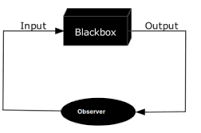Black Box and its Importance
What is the definition of a Black Box?
In science and engineering, a Black Box is a device, system or object which can be viewed in terms of its input, output and transfer characteristics without any knowledge of its internal workings. The name black box (opaq) comes from its feature that internal working is not transparent. Almost anything like human brain, transistor, integrated chip can be referred to as a black box.
Black Box Diagram
Why is Black Box important?
Black Box is the most commonly referred equipment in connection with any aviation disaster. It consists of two separate equipments, a cockpit voice recorder and a flight data recorder. A flight data recorder (FDR) (also ADR, for accident data recorder) is an electronic device employed to record any instructions sent to any electronic systems on an aircraft. It records specific aircraft performance parameters, such as the time, altitude, airspeed and direction the plane is heading. The cockpit voice recorder (CVR), records conversation in the cockpit, communications between the cockpit crew and others including that with air traffic control personnel, and ambient sounds. Any aeroplane is required to be equipped with these equipments. Black Box has no role while the plane is running, but becomes critical in case of a disaster, as it helps the investigators to find out what happened just before the crash.
What are the special features of a Black Box?
Contrary to the "Black Box" reference, the exterior of the FDR is coated with heat-resistant bright orange paint for high visibility in wreckage, and the unit is usually mounted in the aircraft's tail section, where it is more likely to survive a severe crash. A solid state flight data recorder (SSFDR) can store up to 25 hours of flight data. All recorders undergo countless tests. To help locate the equipments in the aftermath of a plane crash that occurs at sea, each recorder is fitted with a device known as an Underwater Locator Beacon (ULB). The device is activated as soon as the recorder comes into contact with water and it can transmit from a depth as deep as 14,000 feet. Once the beacon begins transmitting signals, it does so once per second for 30 days and hence locating the black Box within 30 days is easier. This ultrasonic pulse cannot be heard by human ears but can be detected by sonar and acoustic-locating equipment.
Flight data recorder and Cockpit voice recorder
What is the history of Black Box?
The Black Box was first invented by a young Australian scientist named Dr. David Warren. The first demonstration unit was produced in 1957. In 1960, after an unexplained plane crash in Queensland, Australia became the first country in the world to make the Black Box mandatory for all commercial aircraft.
The "Coding Apparatus for Flight Recorders and the Like" was invented and patented by Professor James "Crash" Ryan from the University of Minnesota . The Cockpit Sound Recorder was invented and patented by Edmund A. Boniface, Jr. Subsequently Boniface filed again on February 4, 1963 for a "Cockpit Sound Recorder" with the addition of a spring loaded switch which allowed the pilot to erase the audio/sound tape recording at the conclusion of a safe flight and landing.
On July 19, 2005, the Safe Aviation and Flight Enhancement Act of 2005 was introduced and referred to the Committee on Transportation and Infrastructure of the U.S. House of Representatives. This bill would require installation of a second cockpit voice recorder, digital flight data recorder system and emergency locator transmitter that utilizes combination deployable recorder technology in each commercial passenger aircraft that is currently required to carry each of those recorders. The deployable recorder system would be ejected from the rear of the aircraft at the moment of an accident.
As technology continues to develop it is likely that Black Boxes, or flight data recorders, will become more and more sophisticated and more reliable.
25 Simple Email Etiquette, Often Ignored And Forgotten
Hologram and Holography in a Nutshell











Hi there, its pleasant paragraph on the topic of media print, we all be familiar with media is a fantastic source of facts.